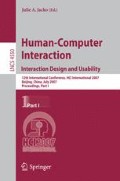Abstract
This paper points out the complementarity of HCI and cognitive science in studying agents’ interactions with their environments. Embodied interaction is related to embodied and distributed cognition. A theoretical framework based on the distinction “potentiality/actuality” is outlined as an approach to the concept of “reality” in HCI and research on presence and copresence. Within this framework presence and copresence are specified in connection with an agent’s potentiality to act upon its environment, i.e. to actively explore and manipulate its environment. Methodological problems concerning theoretical and empirical research on interaction are sketched. To explore new methodological ideas New Media Art is used as a test-bed and an ongoing exploratory experiment on communicating "emotions" through robots is briefly reported.
Access this chapter
Tax calculation will be finalised at checkout
Purchases are for personal use only
Preview
Unable to display preview. Download preview PDF.
References
Agre, P.: Computational Research on Interaction and Agency. Artificial Intelligence 72, 1–52 (1995)
Agre, P.: Computation and Human Experience. Cambridge University Press, Cambridge (1997)
Arbib, M.A., Hesse, M.B.: The Construction of Reality. Cambridge University Press, Cambridge (1986)
Bakeman, R., Gottman, J.M.: Observing Interaction: An Introduction to Sequential Analysis, 2nd edn. Cambridge University Press, Cambridge (1997)
Barnes, J.: Psyche. In: Gregory, R.L. (ed.) The Oxford Companion to the Mind, 2nd edn. pp. 762–763. Oxford University Press, Oxford (2004)
te Boekhorst, I.R.J.A.: Freeing Machines from Cartesian Chains. In: Beynon, M., Nehaniv, C.L., Dautenhahn, K. (eds.) CT 2001. LNCS (LNAI), vol. 2117, pp. 95–108. Springer, Heidelberg (2001)
Dourish, P.: Where the Action Is – The Foundations of Embodied Interaction. MIT Press, Cambridge (MA) (2001)
Essler, W.K.: Einführung in die Logik. Stuttgart: Kröner (1966)
Gibson, E.J., Adolph, K., Eppler, M.: Affordances. In: Wilson, R.A., Keil, F.C. (eds.) The MIT Encyclopedia of the Cognitive Sciences, pp. 4–6. MIT Press, Cambridge (MA) (1999)
Günther, G.: Cognition and Volition: A Contribution to a Cybernetic Theory of Subjectivity. In: Günther, G.: Beiträge zur Grundlegung einer operationsfähigen Dialektik, Bd. II. Hamburg: Meiner (1978)
Heeter, C.: Being There: The Subjective Experience of Presence. Presence: Teleoperators and Virtual Environments 1(2), 262–271 (1992)
Hollan, J.D., Hutchins, E., Kirsh, D.: Distributed Cognition: A New Foundation for Human-Computer Interaction Research. ACM Transactions on Human-Computer Interaction: Special Issue on Human-Computer Interaction in the New. Millennium 7(2), 174–196 (2000)
Hutchins, E.: Cognition in the Wild. MIT Press, Cambridge (MA) (1995)
Hutchins, E.: Cognitive Artifacts. In: Wilson, R.A., Keil, F.C. (eds.) The MIT Encyclopedia of the Cognitive Sciences, pp. 126–128. The MIT Press, Cambridge (MA) (1999)
Ijsselsteijs, W., Riva, G.: Being There: The Experience of Presence in Mediated Environments. In: Riva, G., Davide, F., Ijsselsteijs, W. (eds.) Being There: Concepts, Effects and Measurement of User Presence in Synthetic Environments, pp. 3–16. IOS Press, Amsterdam (2003)
Kac, E.: Telepresence & Bio Art. Networking Humans, Rabbits, & Robots. Ann Arbor. The University of Michigan Press, Ann Arbor, MI (2007)
Licklider, J.C.R.: Man-Computer Symbiosis. In: Wardrip-Fruin, N., Montfort, N. (eds.) The New Media Reader, pp. 74–82. MIT Press, Cambridge (2003)
Lombard, M., Ditton, T.: At the Heart of it All: The Concept of resence (2.1. 2007) Available http://jcmc.indiana.edu/vol3/issue2/lombard.html
Maris, M., te Boekhorst, I.R.J.A.: Exploiting Physical Constraints: Heap Formation Through Behavioral Error in a Group of Robots. In: Proceedings of the IEEE/RSJ International Conference on Intelligent Robots and Systems, pp. 1655–1660. IEEE Press, Piscataway (1996)
Matovani, G., Riva, G.: Real Presence: How Different Ontologies Generate Different Criteria for Presence, Telepresence, and Virtual Presence. Presence: Teleoperators and Virtual Environments 8(5), 538–549 (1999)
Nair, R., Tambe, M., Marsella, S.: The Role of Emotions in Multiagent Teamwork. In: Fellous, J.M., Arbib, M.A. (eds.) Who needs Emotions? The Brain Meets the Robot, pp. 311–329. MIT Press, Cambridge (MA) (2005)
Pfeifer, R., Bongard, J.: How the Body Shapes the Way We Think. MIT Press, Cambridge (MA) (2007)
Rafaeli, S.: Interactivity: Do Computers Do It Differently? Unpublished Manuscript. Standford (CA): Standford University, Institute for Communication Research (1985)
Sharples, M.: Human-Computer Interaction. In: Boden, M.A. (ed.) Artificial Intelligence, pp. 293–323. Academic Press, San Diego (1996)
Sheridan, T.B.: Musings on Telepresence and Virtual Presence. Teleoperators and Virtual Environments 1(1), 120–126 (1992)
Steuer, J.: Defining Virtual Reality: Dimensions Determining Telepresence. Journal of Communication 4(2), 73–93 (1992)
Weinberg, G., Driscoll, S.: Toward Robotic Musicianship. Computer Music Journal 30(4), 28–45 (2006)
Zhao, S.: Toward a Taxonomy of Copresence. Presence: Teleoperators and Virtual Environments 12, 445–455 (2003)
Author information
Authors and Affiliations
Editor information
Rights and permissions
Copyright information
© 2007 Springer-Verlag Berlin Heidelberg
About this paper
Cite this paper
Seifert, U., Kim, J.H. (2007). Entelechy and Embodiment in (Artistic) Human-Computer Interaction. In: Jacko, J.A. (eds) Human-Computer Interaction. Interaction Design and Usability. HCI 2007. Lecture Notes in Computer Science, vol 4550. Springer, Berlin, Heidelberg. https://doi.org/10.1007/978-3-540-73105-4_102
Download citation
DOI: https://doi.org/10.1007/978-3-540-73105-4_102
Publisher Name: Springer, Berlin, Heidelberg
Print ISBN: 978-3-540-73104-7
Online ISBN: 978-3-540-73105-4
eBook Packages: Computer ScienceComputer Science (R0)

